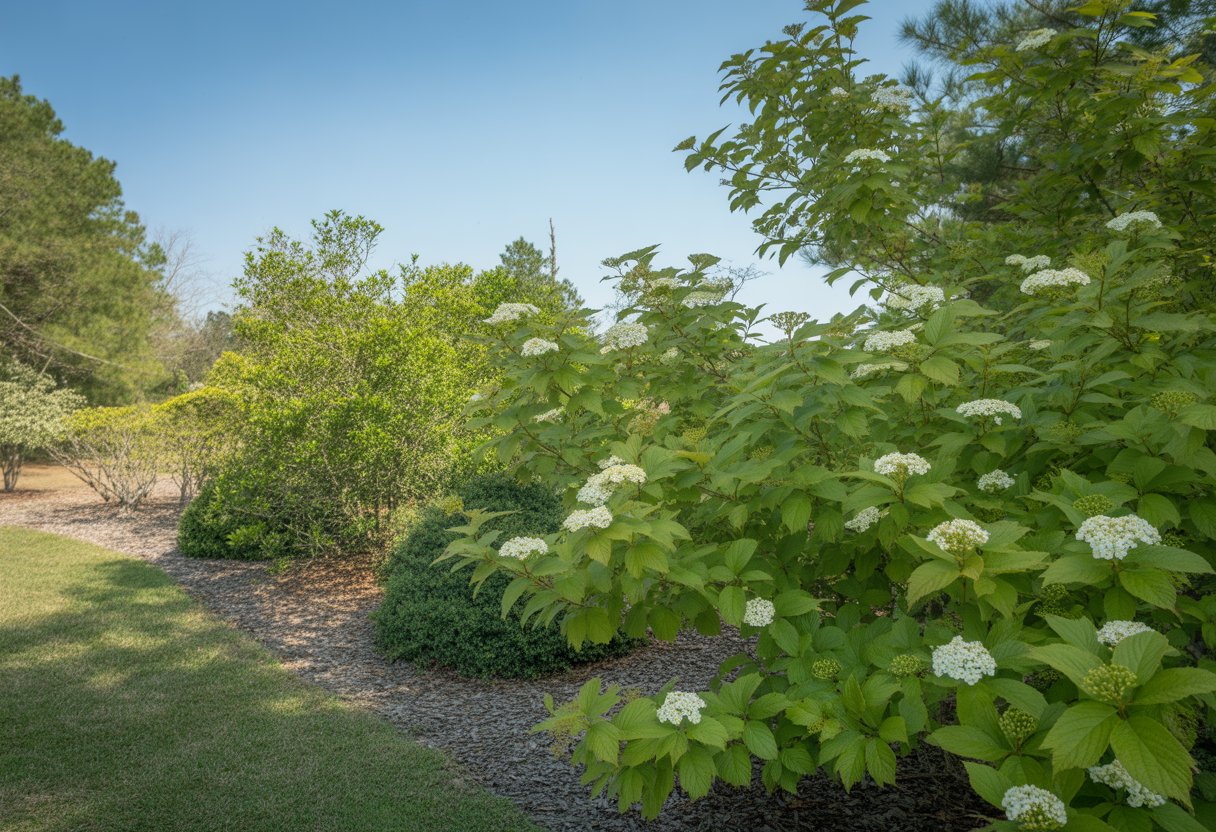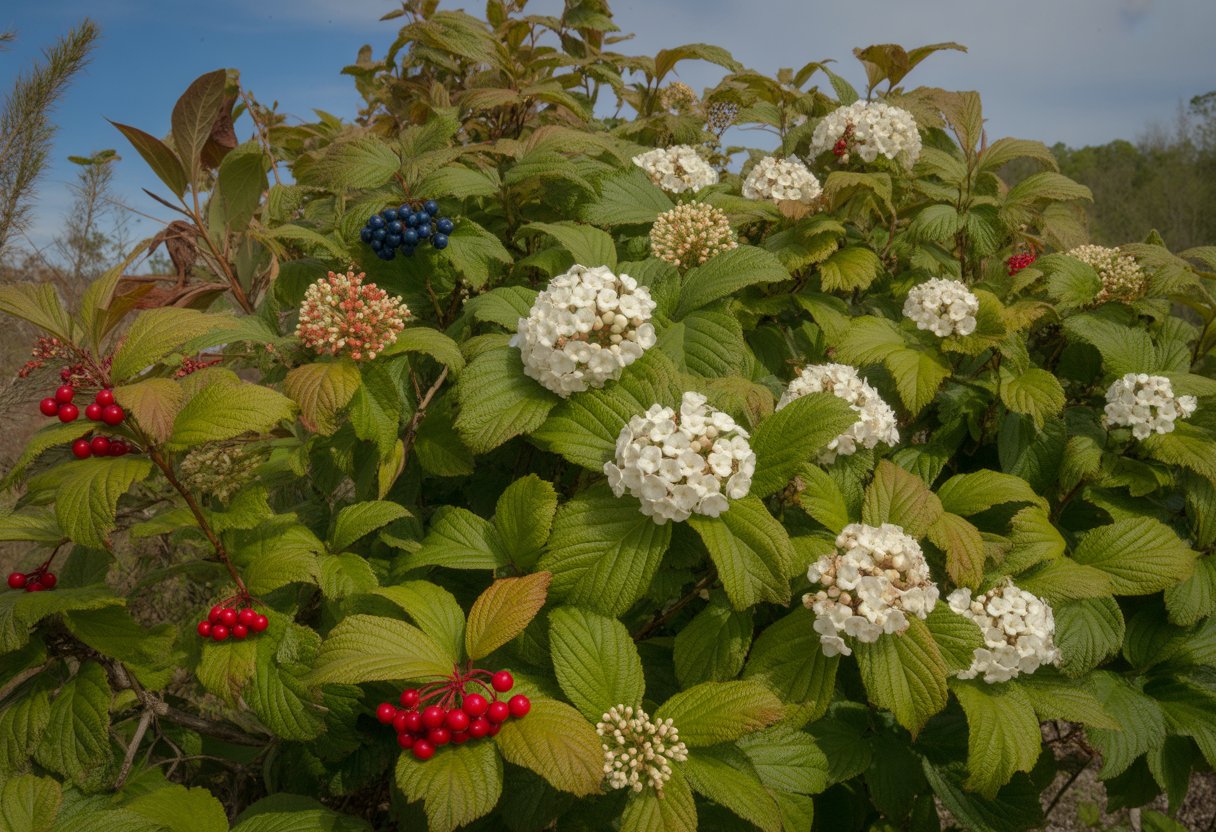Landscaping with Native Viburnum in South Carolina for Sustainable and Attractive Gardens
Landscaping with native viburnum shrubs is a practical and attractive option for South Carolina gardeners. These viburnums handle the local climate and soil with ease, so you don’t have to fuss over them—perfect for both shady corners and sunny spots.

Native viburnums keep gardens interesting all year with their seasonal flowers, berries, and foliage. They support local wildlife and ask for very little in return.
You can fit them into almost any landscape style, whether you’re into formal gardens or something a bit more wild.
If you pick South Carolina native viburnums, your garden will pretty much take care of itself. These shrubs help the ecosystem and cut down on your need for extra watering or chemicals.
Benefits of Landscaping with Native Viburnum
Native viburnums bring a bunch of perks, from boosting local ecosystems to making your garden tougher and more interesting. They handle South Carolina’s climate and soil without much drama, which is honestly a relief.
Ecological Value
Native viburnums play a surprisingly big role in supporting wildlife throughout South Carolina and beyond. Their flower clusters attract bees and butterflies, thanks to their flat-topped, fragrant blooms.
After the flowers fade, these shrubs put out scarlet-red or blue-black berries—prime snacks for birds and small mammals. You’ll spot them along floodplains and woodland edges, quietly keeping biodiversity in check.
Since they’re locals, native viburnums help out more native insects than imported plants ever could. That’s a real win for the ecosystem.
Landscape Performance
These shrubs are hardy and resilient in USDA zones 6 through 9, which covers most of South Carolina. Once they settle in, they shrug off drought and even deer tend to leave them alone.
They don’t mind deep shade, but also look great in partial sun. Use them as foundation plants or tuck them under taller trees—either way, they’ll fill in fast.
Their cold hardiness means they survive the occasional South Carolina winter without much fuss. If you’ve got a soggy spot or a floodplain, they’ll probably be happy there too.
Aesthetic Appeal
Native viburnums put on a show with white, often fragrant flower clusters in spring. Come fall, the berries light up the garden in scarlet-red or blue-black.
You get privacy screens or bold border plants thanks to their rounded form and dense leaves. The combo of dark green foliage and bright fruits is just plain good-looking.
Plus, if you’re into subtle scents, those spring flowers add a nice touch to the air.
Key Native Viburnum Species for South Carolina

There are several native viburnum species that thrive across South Carolina’s different landscapes. They come in evergreen and deciduous shrub types, and each one brings something unique to the table.
Southern Arrowwood (Viburnum dentatum)
Southern Arrowwood is a deciduous shrub you’ll spot pretty often in South Carolina. It usually tops out between 6 and 12 feet, and it loves moist soils near streams or woodland edges.
Come late spring, you’ll see flat-topped clusters of white flowers that pollinators can’t resist. In fall, it’s covered in dark blue-black berries—wildlife love them.
Its leaves turn yellow or red, so you get a splash of color before winter. Southern Arrowwood handles partial shade or full sun, and it’s great for naturalized spots or as a privacy screen.
With dense branches, it’s also a solid pick for stopping erosion on slopes.
Possumhaw Viburnum (Viburnum nudum)
Possumhaw Viburnum stands out for its winter looks. It’s a deciduous shrub that likes wet or moist soils—think swamps and riverbanks.
It blooms with clustered white flowers in spring. By fall, bright red berries show up and sometimes stick around into winter, feeding the birds.
Possumhaw grows between 6 and 10 feet tall. It’s tough in wet spots and draws in plenty of wildlife, so it works well in borders or as a standout in damp gardens.
Small-leaf Viburnum (Viburnum obovatum)
Small-leaf Viburnum is an evergreen shrub that usually stays between 4 and 6 feet tall. It likes well-drained soils and can handle shade or a bit of sun.
Late spring brings fragrant white flowers—they smell great and look tidy. Its dense, glossy leaves stay green all year, making it a reliable choice for evergreen screens.
Once it’s established, it doesn’t mind drought and it puts up with city conditions better than most. You’ll see it in foundation plantings or along woodland edges.
Mapleleaf Viburnum (Viburnum acerifolium)
Mapleleaf Viburnum is a deciduous shrub with leaves that really do look like little maples. Native to South Carolina’s woodlands, it grows 6 to 10 feet tall.
In spring, it puts out small, flat clusters of white flowers, followed by blue-black berries in late summer. The fall foliage can turn a rich red or purple—honestly, it’s pretty striking.
It likes shade or partial shade and prefers well-drained, acidic soils. People often use it in woodland gardens or as an understory shrub for its adaptability and good looks.
Design and Planting Strategies

If you want your native viburnum to thrive in South Carolina, you’ll need to match them to the right spot and pick complementary species. Don’t forget to think about how they’ll look as the seasons change.
Where you plant and what you plant with them makes a big difference for growth and curb appeal.
Site Selection and Growing Conditions
Native viburnums do best in partial shade, but they’ll put up with full sun as long as the soil stays moist. Woodland edges and floodplains are their happy places, since drainage can change with the seasons.
Too much deep shade stunts their growth and cuts down on flowers. Go for well-draining, slightly acidic to neutral soil with some organic matter mixed in.
Skip compacted or bone-dry spots. Give them room to spread so those flower clusters can really show off in late spring.
Companion Planting With Native Species
Viburnum gets along well with azalea and elderberry—other native shrubs that like similar moisture and light. Mixing them up creates layers and boosts habitat value.
Add in understory plants like ferns or woodland wildflowers and you’ll see more pollinators and birds, especially when the scarlet-red berries show up in fall.
Seasonal Interest and Color
Native viburnum keeps things lively through the seasons. Leaves start deep green and can shift to burgundy in fall.
The flower clusters pop in late spring, drawing in pollinators. When autumn rolls around, the berries bring bright, scarlet-red color that sticks around even as everything else goes dormant.
The changing leaves and fruit make South Carolina gardens feel dynamic, not static.
Maintenance, Pests, and Regional Adaptation
Viburnums need some attention to thrive, especially with South Carolina’s climate. Pests and diseases can be a headache, especially the viburnum leaf beetle.
Still, lots of native and hybrid types do well even outside their original range, so you’ve got options.
Care and Pruning for Viburnum
Prune regularly to keep viburnum healthy and in shape—especially if you’re using them as foundation plants. Wait until after they flower to prune, so you don’t accidentally cut off next year’s buds.
Trim out dead or damaged branches to boost air flow and lower disease risk. Watering needs are pretty average.
Viburnums prefer well-drained soil and appreciate a layer of mulch to hold in moisture and keep roots cool. A light dose of slow-release fertilizer in early spring helps encourage blooms.
Pest and Disease Management
The viburnum leaf beetle is the big threat in South Carolina. It chews up leaves and can strip a plant if you’re not careful.
Check your shrubs weekly starting in early spring. If you spot larvae, try insecticidal soap or neem oil right away.
Powdery mildew and aphids also pop up sometimes. Use fungicides or insecticidal sprays if needed, but keeping your plants healthy with good watering and pruning usually goes a long way.
Growing Viburnums in the Southeast and Beyond
Native viburnums aren’t just for South Carolina—they thrive in Alabama, Georgia, and northern Florida too. Some species even stretch into the Midwest, though you might need to protect them a bit in colder states like Indiana or Minnesota.
South Carolina’s humidity supports species like Viburnum macrocephalum, but during dry spells, you’ll need to water them more. Pick types that match your local conditions and you’ll have reliable foundation plants or landscape shrubs for years.
Adaptability and Hybrid Varieties
Hybrids expand your options—they bring better disease resistance and bigger flowers. Varieties that come from native stock usually handle more types of soil and climate than pure native species.
Some hybrids mix traits from Viburnum macrocephalum and local species, so you get larger blooms and longer flowering. They tend to settle in nicely, especially around urban and suburban areas in the southeastern U.S.


